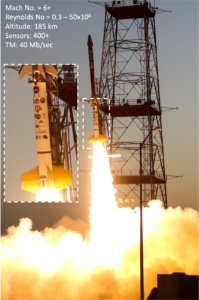 The term Aerothermochemistry was coined by Theodore von Karman, in the 1950’s, to provide a scientific basis for the study of gases taking into account the effects of motion, heat, and chemical changes, which is applicable to aerodynamic and propulsive flows. Hypersonic flight (Mach number > 5) introduces high enthalpy (temperature) aerothermochemical effects.
The term Aerothermochemistry was coined by Theodore von Karman, in the 1950’s, to provide a scientific basis for the study of gases taking into account the effects of motion, heat, and chemical changes, which is applicable to aerodynamic and propulsive flows. Hypersonic flight (Mach number > 5) introduces high enthalpy (temperature) aerothermochemical effects.
The mission of the National Aerothermochemistry and Hypersonics Laboratory (NAHL) is to provide a venue for advanced basic and applied research in non-equilibrium hypersonic gaseous flows and their surface interactions, with applications in hypersonic aerodynamics and propulsion. Originally founded in 2004 by R. Bowersox as the National Aerothermochemistry Laboratory (NAL), the NAHL is celebrating 20 years of serving the students, faculty, and staff of Texas A&M University. We’ve updated the name and logo to reflect the current National interests in Hypersonic flight.
Our approach is founded in modeling, simulation, and experimentation. The included phenomena and environments are hypersonic wall bounded laminar and turbulent viscous flows, high enthalpy non-equilibrium gases and plasmas, surface reactions, supersonic combustion ramjet mixing and flame holding, hypersonic wind tunnel design, advanced laser diagnostic development, and flight test.
 The faculty within the NAHL have been supported by the AFOSR, AFRL, AFC, ARL, Boeing, Lockheed Martin, NASA, ONR, and OUSD(R&E). A defining feature of the NAHL is the suite of national resource quality hypersonic facilities, instrumentation and numerical methods. Most of these assets are one-of-kind, and were developed to address specific problems. A second defining characteristic of the laboratory is the student driven interdisciplinary culture, where researchers from various disciplines (Aerospace Engineering, Chemistry, Physics and Mechanical Engineering) work side-by-side to solve complex problems. A third advantage is the suite of available advanced diagnostic methods associated with the adjacent Aerospace Laboratory for Lasers, Electromagnetics, and Optics (ALLEMO). Our students are routinely employed by the DoD, National laboratories, NASA, universities, and industry.
The faculty within the NAHL have been supported by the AFOSR, AFRL, AFC, ARL, Boeing, Lockheed Martin, NASA, ONR, and OUSD(R&E). A defining feature of the NAHL is the suite of national resource quality hypersonic facilities, instrumentation and numerical methods. Most of these assets are one-of-kind, and were developed to address specific problems. A second defining characteristic of the laboratory is the student driven interdisciplinary culture, where researchers from various disciplines (Aerospace Engineering, Chemistry, Physics and Mechanical Engineering) work side-by-side to solve complex problems. A third advantage is the suite of available advanced diagnostic methods associated with the adjacent Aerospace Laboratory for Lasers, Electromagnetics, and Optics (ALLEMO). Our students are routinely employed by the DoD, National laboratories, NASA, universities, and industry.
BOLT II Flight Test March 21, 2022 (Sponsored by AFOSR, AFRL, USDR&E, and Lockheed Martin)
